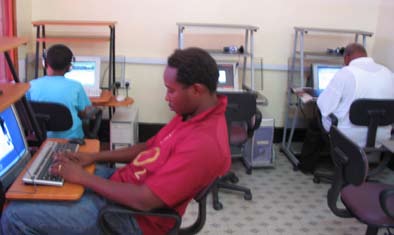



Mathematics 3
Calculus
Prepared by Pr. Ralph W.P. Masenge
African Virtual university
Université Virtuelle Africaine
Universidade Virtual Africana



African Virtual University
Notice
This document is published under the conditions of the Creative Commons
http://en.wikipedia.org/wiki/Creative_Commons
Attribution
http://creativecommons.org/licenses/by/2.5/
License (abbreviated “cc-by”), Version 2.5.

African Virtual University
Table of ConTenTs
I.
Mathematics 3, Calculus _____________________________________ 3
II. Prerequisite Course or Knowledge _____________________________ 3
III. Time ____________________________________________________ 4
IV. Materials _________________________________________________ 4
V. Module Rationale __________________________________________ 5
VI. Content __________________________________________________ 6
6.1 Overwiew ___________________________________________ 6
6.2 Outline _____________________________________________ 6
6.3 Graphic Organizer _____________________________________ 8
VII. General Objective(s) ________________________________________ 9
VIII. Specific Learning Objectives __________________________________ 9
IX. Teaching And Learning Activities _____________________________ 10
9.1 Pre-Assessment _____________________________________ 10
9.2 Pre-Assessment Answers ______________________________ 17
9.3 Pedagogical Comment For Learners ______________________ 18
X. Key Concepts (Glossary) ____________________________________ 19
XI. Compulsory Readings ______________________________________ 26
XII. Compulsory Resources _____________________________________ 27
XIII. Useful Links _____________________________________________ 28
XIV. Learning Activities _________________________________________ 31
XV. Synthesis Of The Module ___________________________________ 77
XVI. Summative Evaluation _____________________________________ 120
XVII. Main Author of the Module ________________________________ 131


African Virtual University
I.
Mathematics 3, Calculus
Prof. Ralph W.P.Masenge, Open University of Tanzania
Figure 1 : Flamingo family curved out of horns of a Sebu Cow-horns
II.
Prerequisite Courses or Knowledge
Unit 1: Elementary differential calculus (35 hours)
Secondary school mathematics is prerequisite. Basic Mathematics 1 is co-re-
quisite.
This is a level 1 course.
Unit 2: Elementary integral calculus (35 hours)
Calculus 1 is prerequisite.
This is a level 1 course.
Unit 3: Sequences and Series (20 hours)
Priority A. Calculus 2 is prerequisite.
This is a level 2 course.
Unit 4: Calculus of Functions of Several Variables (30 hours)
Priority B. Calculus 3 is prerequisite.
This is a level 2 course.


African Virtual University
III.
Time
120 hours
IV.
Material
The course materials for this module consist of:
Study materials (print, CD, on-line)
(pre-assessment materials contained within the study materials)
Two formative assessment activities per unit (always available but with speci-
fied submission date). (CD, on-line)
References and Readings from open-source sources (CD, on-line)
ICT Activity files
Those which rely on copyright software
Those which rely on open source software
Those which stand alone
Video files
Audio files (with tape version)
Open source software installation files
Graphical calculators and licenced software where available
( Note: exact details to be specified when activities completed)
Figure 2 : A typical internet café in Dar Es Salaam

African Virtual University
V.
Module Rationale
The secondary school mathematics syllabus covers a number of topics, including
differentiation and integration of functions. The module starts by introducing
the concept of limits, often missed at the secondary school level, but crucial in
learning these topics. It then uses limits to define continuity, differentiation and
integration of a function. Also, the limit concept is used in discussing a class of
special functions called sequences and the related topic of infinite series.

African Virtual University
VI.
Content
6.1
Overview
This is a four unit module. The first two units cover the basic concepts of the
differential and integral calcualus of functions of a single variable. The third unit
is devoted to sequences of real numbers and infinite series of both real numbers
and of some special functions. The fourth unit is on the differential and integral
calculus of functions of several variables.
Starting with the definitions of the basic concepts of limit and continuity of
functions of a single variable the module proceeds to introduce the notions of
differentiation and integration, covering both methods and applications.
Definitions of convergence for sequences and infinite series are given. Tests for
convergence of infinite series are presented, including the concepts of interval
and radius of convergence of a power series.
Partial derivatives of functions of several variables are introduced and used in
formulating Taylor’s theorem and finding relative extreme values.
6.2
Outline
Unit 1: Elementary differential calculus (35 hours)
Level 1. Priority A. No prerequisite. Basic Mathematics 1 is co-requisite.
Limits (3)
Continuity of functions. (3)
Differentiation of functions of a single variable. (6)
Parametric and implicit differentiation. (4)
Applications of differentiation. (6)
Taylor’s theorem. (3)
Mean value theorems of differential calculus. (4)
Applications. (6)
Unit 2: Elementary integral calculus (35 hours)
Level 1. Priority A. Calculus 1 is prerequisite.
Anti derivatives and applications to areas. (6)
Methods of integration. (8)
Mean value theorems of integral calculus. (5)

African Virtual University
Numerical integration. (7)
Improper integrals and their convergence. (3)
Applications of integration. (6)
Unit 3: Sequences and Series (20 hours)
Level 2. Priority A. Calculus 2 is prerequisite.
Sequences (5)
Series (5)
Power series (3)
Convergence tests (5)
Applications (2)
Unit 4: Calculus of Functions of Several Variables (30 hours)
Level 2. Priority B. Calculus 3 is prerequisite.
Functions of several variables and their applications (4)
Partial differentiation (4)
Center of masses and moments of inertia (4)
Differential and integral calculus of functions of several variables:
Taylors theorem (3)
Minimum and Maximum points (2)
Lagrange’s Multipliers (2)
Multiple integrals (8)
Vector fields (2)

African Virtual University
6.3
Graphic Organizer
This diagram shows how the different sections of this module relate to each
other.
The central or core concept is in the centre of the diagram. (Shown in red).
Concepts that depend on each other are shown by a line.
For example: Limit is the central concept. Continuity depends on the idea of
Limit. The Differentiability depend on Continuity.
Functions
Functions
of a single
of several
variable
variable
Differentiability
L imit
Continuity
Integrability
Sequence
Infinite
Series

African Virtual University
VII. General objective(s)
You will be equipped with knowledge and understanding of the properties of
elementary functions and their various applications necessary to confidently teach
these subjects at the secondary school level.
You will have a secure knowledge of the content of school mathematics to confi-
dently teach these subjects at the secondary school level
You will acquire knowledge of and the ability to apply available ICT to improve
the teaching and learning of school mathematics
VIII. specific learning objectives
(Instructional objectives)
You should be able to demonstrate an understanding of
• The concepts of limits and the necessary skills to find limits.
• The concept of continuity of elementary functions.
• … and skills in differentiation of elementary functions of both single and
several variables, and the various applications of differentiation.
• … and skills in integration of elementary functions and the various appli-
cations of integration.
• Sequences and series, including convergence properties.
You should secure your knowledge of the following school mathematics:
• Graphs of real value functions.
• Idea of limits, continuity, gradients and areas under curves using graphs of
functions.
• Differentiation and integration a wide of range of functions.
• Sequences and series (including A.P., G.P. and ∑ notation).
• Appropriate notation, symbols and language.

African Virtual University 0
IX.
Teaching and learning activities
9.1
Pre-assessment
Module 3: Calculus
Unit 1: Elementary Differential Calculus
1. Which of the following sets of ordered pairs (x, y) represents a function?
(a)
(1,1), (1,2), (1,2), (1,4)
(b)
(1,1), (2,1), (3,1), (4,1)
(c)
(1,1), (2,2), (3,1), (3,2)
(d)
(1,1), (1,2), (2,1), (2,2)
⎧(a)
⎪⎪( )b
⎨
The set which represents a function is
⎪ (c)
⎪⎩(d)
2. The sum of the first n terms of a GP, whose first term is a and common
n+1
⎡1 − r
⎤
ratio is r , is S = a
. For what values of r will the GP converge?
n
⎢ 1 r ⎥
−
⎣
⎦
⎧(a) r < −1
⎪( )
b
r = 1
The GP will converge if
⎪⎨⎪(c) r >1
⎪⎩(d) r < 1

African Virtual University
3. Find the equation of the tangent to the curve
2
y = 2x − 3x + 2 at (2, 4) .
⎧(a) y = 5x + 6
⎪⎪( )b y = 6x −5
The equation of the tangent at (2,4) is ⎨⎪(c) y = 5x−6
⎪⎩(d) y = 6x + 5
d2 y
dy
4. Given the function y = sin(x) + cos(x) ,
find
+ 2
− y .
dx2
dx
⎧(a) − 4sin(x)
⎪⎪( )b 4cos(x)
The value of the expression is ⎨⎪(c) 4sin(x)
⎪⎩(d) − 4cos(x)
5. Using Maclaurin’s series expansion, give a cubic approximation of y = tan(x) .
⎧
1 3
⎪
1+ x + x
3
⎪(a)
1
⎪
3
x
x
⎪
−
( )
b
The required cubic is
3
⎨(c)
1
⎪
1− x +
3
x
⎪
3
(d)
⎪
1 3
⎪
x + x
⎩
3

African Virtual University
Unit 2:
Elementary Integral Calculus
⎧(a) Non − existent
⎧ 2
x
⎪
− 2
x ≥ 2
⎪( )
b
− 2
6. If f (x) = ⎨
then, lim f (x) = ⎨
⎩ x − 4
x < 2
x→2
⎪(c)
2
⎪⎩(d)
0
⎧
x
(a)
x
⎪
df
⎪
x−
b
( )
x 1
7. If
x
f (x) = x
Then
= ⎨
x
dx ⎪(c) x 1[+ ln(x)]
⎪
x
⎩(d)
ln(x)x
8. The anti-derivative of a function f (x) is defined as any function whose
derivative is f (x) . Therefore, the anti-derivative of
− x
f (x) = sin(x) + e
⎧(a) − cos(x) + −x
e
⎪⎪( )b cos(x) − −x
e
is F (x) = ⎨
−x
⎪(c)
cos(x) + e
⎪
−x
⎩(d) − [cos(x) + e ]
9. A trapezium (also known as a trapezoid) is any quadrilateral with a pair of
opposite sides being parallel. If the lengths of the sides of a trapezium are f
0
and f , and if the distance between the pair of parallel sides is h , then the
1
⎧
(
h f
f )
0 +
1
⎪(a) h
( )
(f
f
0 −
1 )
⎪⎪ b
area of the trapezium is
Area =
2
⎨(c) (
h f
f )
⎪
0 −
1
⎪(d) h (f
f
0 +
1 )
⎪⎩
2

African Virtual University
10. If the points A(− ,
h f ) , B (0, f ) , C ( ,
h f ) , lie on a parabola
−1
0
1
y = ax2 + bx+ c , then, it can be shown that:
f − 2 f + f
f − f
1
0
1
A = −
, B
1
0
=
, and C = f .
2
2h
2h
0
Then, the area under the parabola that lies between the ordinates at x = −h
⎧
h (f 4
1 +
f0 + f
−
1 )
⎪
2
⎪(a) h (f 4
1 −
f0 + f
h
b
( )
−
1 )
⎪⎪
and x = h is given by
∫ ydx=
3
⎨
−h
(c) h
⎪
(f
4
1 +
f0 + f
−
1 )
⎪(d 3
)
⎪
h (f 4
1 +
f0 + f
−
1 )
⎪⎩
2
Unit 3: Sequences and Series
2
3
4
5
11. The first four terms of a sequence {a are ,
,
,
.
n }
3
5
7
9
⎧
28
⎪(a)
47
28
⎪⎪( )
b
Therefore, a
57
27 =
⎨(c) 28
⎪
49
⎪(d) 28
⎪⎩
55

African Virtual University
⎧(a) −1
⎪
1
⎪( )
b
1
12. The limit L of a sequence with a
is
L =
n =
(
n n
⎨
+1
(c) 0
⎪⎪
1
⎩(d)
2
13. The sequence whose n − th term is given by a
is:
n = (
)n 1
1 +
−
⎧(a) convergent
⎪⎪ b
( ) increa sin g
⎨⎪(c) divergent
⎪⎩(d) decreasin g
14. If {a is a sequence of real numbers, and if lim a = L , then the infinite
n }
n
n→∞
⎧(a) L < ∞
⎪
∞
( )
b
L =< 1
series ∑ a converges only if
⎪
k
⎨ (c) L 0
k
=
=1
⎪⎪⎩(d) L <1
⎧
1
⎪
1− n
⎪(a)
1
n
1
1
⎪
1
⎪
−
b
( )
15. If
S
then
n +
S
1
n = ∑ ⎛
⎞
⎜ −
⎟
n = ⎨( ) 1
1
k
c
1
k n 1
= ⎝
+ ⎠
⎪
−
⎪
n n
(d)
+1
⎪
1
1
⎪
−
⎩
n +1 n

African Virtual University
Unit 4: Calculus of Functions of Several Variables
16. The area enclosed by the curve y = 4 and
2
y = 1 + x is
(a) = 3 20
(b) = 7
(c) = 0
(d) = 20 3
17. If f ( ,
x y) = ln( 3
2
2
3
x − x y + y ) and g(t) = e−t sin(t) ,
t h e n
g(f (x, y)) is given by:
sin( 3
2
2
3
x − x y + y )
(a) = ln( 3 2 2 3
x − x y + y )
sin[ ln( 3
2
2
3
x − x y + y ) ]
(b) =
ln( 3
2
2
3
x − x y + y )
sin[ln( 3
2
2
3
x − x y + y ) ]
(c) =
( 3 2 2 3
x − x y + y )
( 3 2 2 3
x − x y + y )
(d) = sin[ ln( 3 2 2 3
x − x y + y ) ]
18. The volume V of an ideal gas depends on (is a function of) two independent
variables, namely, temperature T and pressure P. Specifically,


























